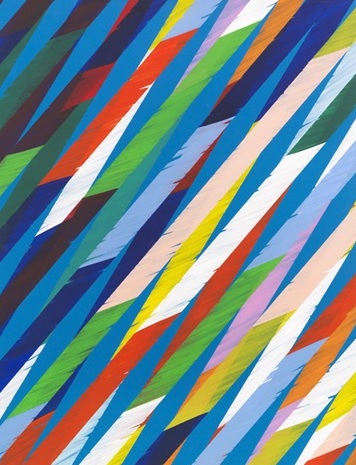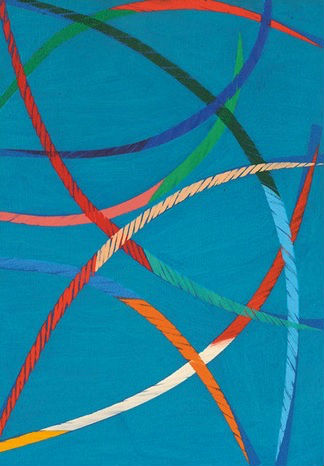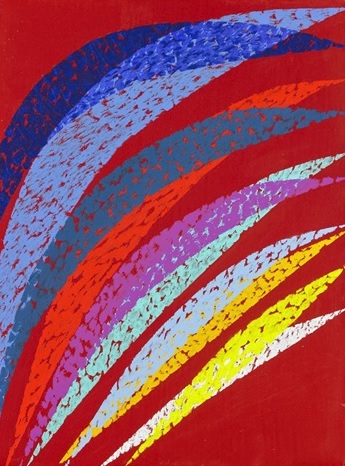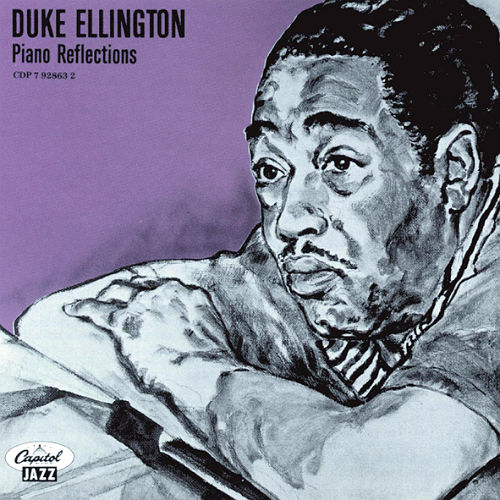Duke Ellington
MARK TUCKER ON DUKE ELLINGTON: PIANO REFLECTIONS
The following text constitutes the liner notes to the Duke Ellington album, Piano Reflections (Capitol Jazz, 1953).
‘Ellington plays the piano,’ Billy Strayhorn once observed, ‘but his real instrument is his band.’ That statement has assumed a lapidary quality over the years, helping to reinforce the widely-held view that Duke Ellington was a composer first, a performer second. Ellington himself resisted this ranking. ‘I like any and all of my associations with music,’ he wrote in his memoirs. ‘None is as important as—or more important than—the one being enjoyed at the moment.’ It took Ellington a while to arrive at this state of equanimity. For in the beginning he clearly set his sights on mastering the keyboard.

Pierro Dorazio, Grazia (Azzuro), 2000

Piero Dorazio, Eximisi III, 2001
In his hometown of Washington, D.C. in the early 1900s, young Edward Kennedy Ellington began his study of the piano with Miss Marietta Clinkscales, a neighborhood teacher. The lessons didn’t count for much, though, and he ‘missed more than he took, because of my enthusiasm for playing ball, and running and racing through the street.’ One summer vacation about 1914, however, the fifteen¬year-old Ellington had as inspiring encounter with pianist Harvey Brooks in Philadelphia: ‘Harvey was not selfish. When I told him about my resolve, he encouraged me, and taught me many of the shortcuts that he had figured out to successful playing’.
Back home the teenager began practicing in earnest and picking up pointers from such local ragtime wizards as Oliver ‘Doc’ Perry, Louis Brown, Gertie Wells, Sticky Mack, and the mysterious ‘Man with a Million Fingers.’ Soon he had come up with his own solo vehicle—Soda Fountain Rag—which he played in the Poodle Dog Cafe as a ‘one-step, two-step, waltz, tango, and fox trot,’ often substituting for the regular pianist (who tended to get sleepy after a while and fall off his stool). By 1921 Ellington was winning piano contests, competing against local rivals like Claude Hopkins and visiting stars like Lucky Roberts. That same year, Ellington got a chance to perform Carolina Shout for its composer James P. Johnson, the New York virtuoso whose piano roll of the piece Duke had learned note-for-note a few years earlier.

Piero Dorazio, Pet Bay, 2000

Piero Dorazio, Rosso, 2001
When Ellington moved to New York in 1923 he began making the rounds of parlor socials and after-hours clubs with James P. and other Harlem pianists, among them Willie ‘the Lion’ Smith, Thomas ‘Fats’ Waller, Alberta Simmons, Corky Williams, Stephen ‘the Beetle’ Henderson, and the legendary ‘Abba Labba’ (Richard McLean) and Raymond ‘Lippy’ Boyette (who, according to Ellington, ‘had heard so much piano he couldn’t play any more. He only thought piano’). Of all these players, Smith made the strongest impression: ‘Willie the Lion was the foundation. He not only had his own natural inclinations towards piano devices, but if he thought you worthy of instruction he would demonstrate and show you the varying styles of his predecessors and their ways and means of playing the piano.’ Later Ellington acknowledged the debt by writing two musical ‘portraits’ of his piano parent.
In the mid-1920s Ellington was trying to succeed in New York on various fronts—as bandleader, recording artist, songwriter, and composer-arranger. By then the piano seems to have become a means for realizing these ends, not the main focus of Ellington’s musical activity. Recordings from this time—although in short supply and perhaps unrepresentative of what Ellington’s band could really do—show Ellington as a well-developed pianist in the ‘Harlem stride’ idiom. Listen to his solo on Deacon Jazz (1924), for example, or his fiery outing on Georgia Grind (1926). By contrast, his composing skills lagged behind, as Parlor Social Stomp from 1926 demonstrates.

Piero Dorazio, Auriol II, 1997

Piero Dorazio, Candido, 1997
Soon, however, Ellington’s band began recording pieces like East St. Louis Toodle-o, Black and Tan Fantasy, and Creole Love Call—works tailored for (and shaped by) his individual players rather than orchestrated ragtime. After moving into Harlem’s famed Cotton Club in December of 1927, Ellington’s composing abilities continued to grow at a rapid rate. It was during his band’s first year at the Cotton Club that Ellington made his recording debut as a solo pianist, in October of 1928, producing two originals, Black Beauty and Swampy River, the former a poignant tribute to the black entertainer Florence Mills, the latter a blending of Lion-esque lyricism and rollicking boogie woogie.
When the Ellington orchestra began drawing international attention in the 1930s, it was mostly on the basis of its leader’s compositions and its players’ distinctive styles. To be sure, Ellington often led from the keyboard and occasionally served as featured soloist in his arrangements. But a flashy piano showpiece like Lots o’ Fingers (1932) was unusual in the Ellington repertory. From time to time there would be works spotlighting Ellington’s keyboard talents in an orchestral setting—Blue Belles of Harlem (1938), New World a’ Coming (1943), The Clothed Woman (1947), and Ad Lib on Nippon (1965)—but overall Ellington’s role as a soloist in his band was less dominating than it was, say, for Earl Hines and Count Basie.

Piero Dorazio, Impasse I, 2002

Piero Dorazio, Fugentti VIII, 1985
Even so, Ellington continued to display his pianistic prowess in rhapsodic introductions, atmospheric solos, low-down blues choruses, and hard-driving stride interludes. He also made occasional recordings both alone or accompanied by one or two players, beginning with a series of sides in 1939-40 featuring the young bass virtuoso, Jimmy Blanton.
Ellington’s most important recording as a pianist, however, came with the release of Piano Reflections, an album featuring performances recorded for Capitol in April and December of 1953. Backed by bassist Wendell Marshall and two different drummers—Butch Ballard in April and Dave Black in December—Ellington performed fourteen pieces, eight of them new. This burst of pianistic activity in the studio foreshadowed the 1960s, when Ellington would make more recordings with bass and with trio (including the notorious Money Jungle session with Charles Mingus and Max Roach in 1962), and when he would begin to give public solo piano recitals.

Piero Dorazio, Senza titulo, 1981

Piero Dorazio, Senza titulo, 1995
Out on the West Coast in the spring of 1953, Ellington’s orchestra made its first recordings for Capitol on April 6, in a session that produced a piece called Satin Doll. A week later Ellington returned to the studio with Marshall and Ballard, leading off with three new piano compositions: Who Knows?, Retrospection, and B Sharp Blues.
The main theme of Who Knows? displays Ellington’s chromatic bent (which he once traced to the noted arranger Will Vodery), while the bridge features left-hand voicings associated with Willie ‘the Lion’ (cf. Morning Air, recorded in 1939). Ellington’s two solo choruses show his mastery of register, as he gracefully executes large leaps and now and then cascades down the keyboard with runs of startling intensity. The mood quiets down with Retrospection, a sober meditation with harmonies that echo the Victorian parlor songs and hymns of Ellington’s youth. The performance of B Sharp Blues is as witty as its tongue-in-cheek title, with Ellington’s sudden surprising dissonances, his sly allusions to a theme from Diminuendo and Crescendo in Blue (1937), and his pared-to-the-bone lines which, in the hands of a lesser pianist, might sound like clichés. Ellington’s transforming touch, however, gives them a brittle, modern quality that may remind some listeners of Thelonious Monk.

Piero Dorazio, Aloof II, 2002

Piero Dorazio, Siris II, 1998
To round out the session Ellington turned to two pieces that dated from the previous decade. Billy Strayhorn’s Passion Flower, first recorded by Johnny Hodges and a small group in 1941, had become one of the alto saxophonist’s primary vehicles. In 1953 it was still in the Ellington band’s repertory even though Hodges had departed two years earlier (only to rejoin in 1955). Ellington’s interpretation manages to suggest a sense of erotic anticipation even if something of Hodges’s warmth and sensuality are missed. On Dancers in Love, however, from the 1944 Perfume Suite, Ellington captures the youthful ebullience’ of the original. In his memoirs, he wrote that the piece represented ‘naiveté, a stomp for beginners,’ and the deliberately basic chord sequence following the chromatic first theme underscores the dancers’ adolescent infatuation.
The next day, April 14, Ellington began with two haunting compositions, Reflections in D and Melancholia, accompanied only by Marshall on bowed bass. Both pieces point to the difficulty—futility even—of trying to categorize Ellington’s music, for while they draw upon the harmonic vocabulary of jazz, their rhythmic freedom and ethos seem to belong to another world altogether: an idealized realm of memory, nostalgia, and spirituality more characteristic of the nineteenth century than the twentieth. In the context of Ellington’s overall output, these two works—together with the previous day’s Retrospection— form a link between earlier ‘mood pieces’ (Awful Sad, Mood Indigo, Solitude) and the sacred music of the ‘60s (Meditation, Heaven, T.G.T.T.).

Piero Dorazio, Calumet, 2002

Piero Dorazio, Arboisier, n.d.
Framed by a lovely bell-like figure, Reflections in D has the private quality of a prayer—the listener almost feels like an eavesdropper on an interior monologue, yet privileged to be allowed so near. For Melancholia Ellington drops down a half-step to D-flat for a gentle piece edged in sorrow. (Recently the trumpeter Wynton Marsalis has been attracted to Melancholia’s special qualities, recording it on two of his albums.)
For the next four offerings Ellington dipped again into his repertory of standards. Prelude to a Kiss, first recorded in 1938, was another Johnny Hodges feature. Unlike the sustained melody notes of Passion Flower, however, its moving chromatic lines adapt easily to keyboard treatment. Ellington’s tone is warm and rich; he sticks close to the theme throughout, as though it were too lovely to let go. This performance could serve as a study for all pianists in how to balance chords and produce a full-bodied sound without exerting undue pressure. In the early days Ellington emulated Lucky Roberts and some of the ragtime pianists by throwing his hands high off the keyboard and, accordingly, producing a more percussive sound. But by 1953 he had settled down a bit, and film footage from the later years shows him keeping his hands quite close to the keys, his wrists supple, and his fingers slightly curved in ‘classical’ position.

Piero Dorazio, Artemis I, 1963

Piero Dorazio, intimità, 2002
If Prelude to a Kiss is a study in tone, In a Sentimental Mood demonstrates Ellington’s inimitable touch. Especially impressive is the way he shades each note of the theme by either quick releases, half-pedaling, or finger legato. The constant variety of attacks and releases makes the familiar theme fresh. The trio settles into a relaxed blues groove on Things Ain’t What They Used to Be, demonstrating close ensemble interplay with Marshall’s fills, Ballard’s punctuating accents, and in the second chorus, Ellington’s tremolo response to a drum roll. This performance reveals how Ellington preferred building blues choruses out of short motives rather than soloing on the changes. A good example is in the fourth chorus, when Ellington ‘worries’ a two-note figure spaced over an octave apart. Ellington probably derived this practice from the ragtime and stride players, for whom melodic elaboration and embellishment took precedence over harmony-generated improvisation.
All Too Soon, first recorded in 1940 as a feature for trombonist Lawrence Brown and tenor saxophonist Ben Webster, later performed as a song with Carl Sigman’s lyrics, is one of Ellington’s most inspired melodies. Even without a text it tells a story through a series of connected, unfolding statements. Although the piece follows the conventional AABA pop song plan, Ellington wrote a varied, summary-like phrase for the last A section which enhances the narrative quality (i.e., the song’s bridge leads not back to the beginning but to somewhere new). As with the preceding three standards, Ellington treats All Too Soon not as a vehicle for improvisation but as an affirmation of melody.

Piero Dorazio, Printemps, 2002

Piero Dorazio, Alter Ego I, 2004
Janet is perhaps the most unusual piece Ellington recorded on these two days. Apparently named after the daughter of a friend, it was performed rarely by Ellington (he did include it on his first public piano recital, 14 January 1962, at the Museum of Modern Art). What’s different is the form: a slow, moody middle flanked by two lively outer sections (turning inside out the scheme found in The Clothed Woman of 1947.) Perhaps the contrasts reflect Janet’s different traits or moods. Ellington often cited various stimuli that inspired his compositions—natural phenomena, places, people, states of feeling, even trains (both express and local). In this case, the three-part Janet succeeds as a miniature tone portrait while the identity of its subject remains obscure.
Back in New York by the end of 1953—with Wendell Marshall again and a new drummer, Philadelphian Dave Black—Ellington went into the studio on December 3 and recorded three originals. The mood on this date seems different from the two earlier in April—more tense, unsettled, and rhythmically agitated. Although Ellington’s playing on Kinda Dukish is energetic and aggressive, he also leaves considerable space to be filled by his accompanists. One interesting feature is the unpredictable alternation between C major and A minor in the middle sections. Although C major is clearly re-established when the main theme returns, Ellington and Marshall end the piece with a low A, leaving the tonic identity of the piece unresolved. Listeners who know Kinda Dukish as a favorite solo piano introduction to Rockin’ in Rhythm may be surprised when, halfway through the performance, the famous crashing chords do not usher in the well-known Ellington standard.

Piero Dorazio, Giardino, 1967-79

Piero Dorazio, Fluted Dance, 1967
The rhythmic energy of Montevideo (earlier issued under the title Night Time) emanates not just from drummer Black but from Ralph Collier’s conga work, Marshall’s powerful vamping and expressive slides, and Ellington’s own percussive effects on the keyboard. Midway through Ellington states a more lyrical theme in octaves before returning to the churning syncopated figures that pervade this Latin-tinged piece.
December Blue combines pretty, decorative harmonies with earthy blues figures, as though Ellington were fusing two genres. Echoes of There Was Nobody Looking from the Deep South Suite (1946) sound in both the opening and closing sections, and though the piece has an informal, after-hours quality, Ellington obviously had planned the contrast between the main song-like theme and the inner ad lib blues choruses.

Piero Dorazio, Senza titolo, 1994

Piero Dorazio, Coup de dées II, 1999
In December Blue, as in all of Ellington’s keyboard statements, the shaping, ordering hand of a composer is present together with a performer’s keen sensitivity to sound. The piece serves as a reminder that Ellington’s excellence derived not just from playing and composing but from listening. As he noted in 1965, ‘If you love music, then it follows you love to listen to it, which makes the ear the most essential instrument, the most essential musical instrument in the world.’ Maybe Strayhorn was wrong: Ellington played the piano and wrote for his orchestra, but his real instrument was the ear.
DUKE ELLINGTON’S ‘PIANO REFLECTIONS’ IN ‘MARA, MARIETTA’
FROM ‘MARA, MARIETTA’
Part Ten Chapters 12, 13
… and now the mood is Ellingtonian: The Duke himself is playing a rich chord progression. As he thickens the chromatic descent with suspended harmonies, ‘Prelude to a Kiss’ sounds more like post-coitum blues: Tenderness and nostalgia, sadness and loss, emerge to colour the melodic motifs. Keeping the melody moving, the tone combinations envelop me in the sensuality of their sound.

Duke Ellington | Photo : Lisette Model

Duke Ellington
Your body sways as Ellington plays the lilting riff of a twelve-bar blues: ‘Things Ain’t What They Used to Be’. Like a river current the rhythm gathers us in its forward motion; in our blood we feel the underlying pulse. Floating on this luxurious surge, our bodies move still closer together: With his distinctive touch the Duke finds the supple rhythm of slow love-making, the elusive groove of a leisurely fuck. Now he lets the tone linger, now he strikes it staccato; now he plays it in a whisper, now he bangs it out loud: No matter what the touch, the message is the same: Titi-boom, spang-a-lang, you’re my baby!
Here she comes, a pleated silk blouse over a black bustier, a man in an open-necked shirt and a 3-day beard beside her. We invite them to sit down. He’s Raphaël, she’s Maya. Revelling in the oyster she’s sucked from the shell, she swallows it then says:
̶ I like this music.
I like her green-grey eyes, her shaggy black bob.
̶ Me too, I say.
At a sprightly clip, Ellington gives his signature buoyancy to ‘B Sharp Blues’. Infectiously communicative, between relentless movement and supreme relaxation the swing suspends us all in its contradiction.

Duke Ellington | Photo: Ted Williams
SPOTIFY: DUKE ELLINGTON, PIANO REFLECTIONS

Duke Ellington | Photo:Roberto Polillo, 1964

Duke Ellington: Piano Reflections

Duke Ellington | Photo: Baron Wolman, 1972
YOU CAN LISTEN TO THE ALBUM IN FULL WITH A REGISTERED SPOTIFY ACCOUNT, WHICH COMES FOR FREE
VIDEO: DUKE ELLINGTON, PIANO: LIVE
Duke Ellington: Solo Piano Concert and Talk
DUKE ELLINGTON: THREE BOOKS

Duke Ellington: An American Composer and Icon

Duke: A Life of Duke Ellington | NYT review
